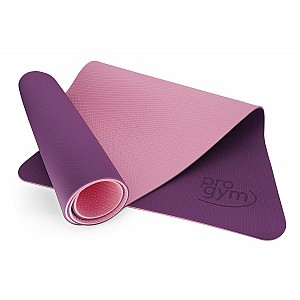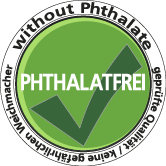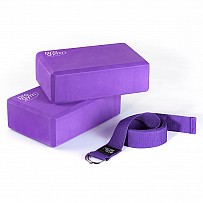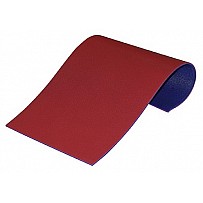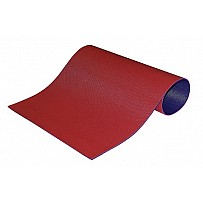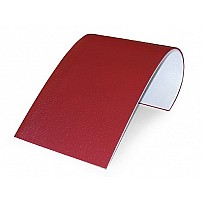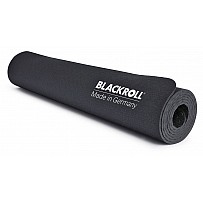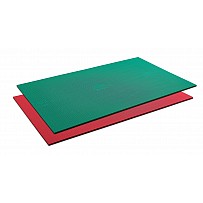Set
from
11,90 €
PROGYM Yoga mat - gymnastic mat non-slip
The PROGYM gymnastics mat impresses with its increased TPE content and high tear resistance, thus ensuring a long service life. The professional mat can be used in yoga, gymnastics, fitness and Pilates. Due to the improved, double-sided structure, the PROGYM mat is much more non-slip and therefore ideal for people who value safety.
Due to the 6 mm thick material, the yoga mat is particularly easy on the joints and pleasantly soft. It offers maximum comfort for knees, elbows and hips.
Due to the 6 mm thick material, the yoga mat is particularly easy on the joints and pleasantly soft. It offers maximum comfort for knees, elbows and hips.
Specifications:
- Material: Eco-friendly TPE / TPR
- Dimensions (L x W x H) 183 x 61 x 0.6 cm
- Construction: Double-layer base
- Non-slip, easy-to-clean surface
- Available in 3 color combinations: blue-light blue, lilac-pink, anthracite-red
Area of application:
- Yoga (Joga / Yuga) - classic & modern yoga -
- Fitness, training, coordination - stability and balance (e.g. by standing on one leg, side plank, etc.)
- Gymnastics, aerobics, functional gymnastics - dynamic, rhythmic movements in training
- Pilates, Powerhouse - Rehab and Deep Muscle Training & Strengthening
- Studio and home fitness - three-dimensional exercises to activate holistic muscle groups
Description
The PROGYM yoga mat impresses with its increased TPE content and its high tear resistance, ensuring long durability. The professional mat can be used in yoga, gymnastics, fitness and Pilates. Thanks to the improved, double-sided structure, the PROGYM yoga mat is significantly more non-slip and therefore ideal for people who place a high value on safety.
The 6 mm thick material makes the yoga mat particularly gentle on the joints and pleasantly soft. It offers maximum comfort for knees, elbows and hips.
What is the difference between an exercise mat and a yoga mat?
The main difference between a yoga mat and an exercise mat is usually the thickness/strength. Yoga mats are usually considerably thinner than an exercise mat. A gymnastics mat is 0.9 cm - 2.8 cm thick, whereas a yoga mat is usually around 0.6 cm thick. Since a yoga mat has to be easy to handle, transport, set up and dismantle, the compact and thin design is an advantage.
What should you consider when ordering yoga mats?
The right yoga mat can be recognized by the essential points for yoga mats, which stand for good functionality as well as quality and longevity. Good yoga mats have an increased TPE content, which has a positive effect on tear resistance and flexibility. A higher tear resistance also brings with it a higher/longer durability. In addition, good yoga mats are made of a particularly non-slip material that allows the athlete to use the mat in almost any situation. Thanks to the improved, double-sided texture, the yoga mat impresses with its special slip resistance and is at the same time gentle on the joints and pleasantly soft. For easy and space-saving storage, the PROGYM yoga mat has a practical carrying strap that also allows for comfortable transport
What can you use a yoga mat for?
Yoga mats are suitable for use in yoga as Pilates mats, fitness mats or sports mats. The mats, which were originally conceived and designed for yoga, are now often used for floor sports and gymnastics due to their great flexibility and versatility.
How big should a yoga mat be?
The optimal size of the yoga mat that is suitable for each athlete depends on their body size. The ideal length of the yoga mat is approx. 10 cm longer than your body height. If you are 175 cm tall, a length of 185 cm is ideal for the yoga mat. The common standard length is now 183 cm, with which most body sizes achieve optimal training success. The situation is similar with the width, which is now set at 61 cm, analogous to the length standardization.
What are the advantages of the PROGYM yoga mat
The PROGYM yoga mat has excellent cushioning properties and a flexible, soft surface structure. It can be rolled up in no time and ready for transport for the next use. The special structure brings further flexibility and the possibility of use in a wide variety of yoga styles. A practical carrying strap is included in delivery.
Is the PROGYM yoga mat suitable for indoor and outdoor use?
The PROGYM yoga mat can be used for indoor and outdoor training. Due to the special material properties and composition, it can be designed on almost all surfaces. Basically, there are almost no restrictions when choosing the right surface for yoga. The PROGYM yoga mat provides good grip on wooden floors, parquet floors or even mineral stone floors. The unyielding surface of the parquet or stone floor improves stability and stability compared to comfort. If you choose a soft carpet as the surface, it should be cleaned so that the PROGYM yoga mat cannot slip. In the outdoor area, for example in a meadow with short grass, it is important that it is dry. After use, depending on how dirty it is, cleaning is recommended in order to achieve optimal training results the next time you train.
What material is a yoga mat made of?
A yoga mat is usually made of the material “TPE” / “TPR”. The term "TPE" stands for "thermoplastic elastomers" / "thermoplastic rubber" and describes a material with properties similar to rubber that have been combined with the properties of thermoplastics. “TPE” has the possibility of being plastically deformed when thermal heat is applied and, for example, processed into a yoga mat. Thermoplastic elastomers have been increasingly used since the middle of the last century. The material "TPE" is non-toxic as it does not contain any plasticizers or heavy metals and is environmentally friendly as it is 100% recyclable and biodegradable.
The PROGYM yoga mat combines outstanding features that make it a first-class choice for yoga, gymnastics, fitness and Pilates. Their increased TPE content not only ensures impressive tear resistance, but also long durability. The improved double-sided structure provides exceptional slip resistance, ideal for those who value safety. With a thickness of 6 mm, the mat is particularly gentle on the joints and offers maximum comfort for knees, elbows and hips.
For optimal training results, the right yoga mat is recommended, and this is where the PROGYM yoga mat shines with its TPE content, non-slip material and joint-friendly properties. The flexible usability for various sports and the possibility of indoor and outdoor use make them particularly versatile.
Overall, the PROGYM yoga mat is an outstanding choice for anyone who values quality, functionality and sustainability. Its versatile range of uses and positive properties make it an ideal companion for yoga enthusiasts and sports lovers.
Discover the PROGYM yoga mat - your ultimate solution for yoga, gymnastics, fitness and Pilates. With its increased TPE content, this professional mat offers impressive tear resistance and durability that will take your practice to new levels. The sophisticated double-sided structure gives the mat outstanding slip resistance, ideal for anyone who prioritizes safety and stability during their exercises.
The PROGYM yoga mat is characterized by a 6 mm thickness, which offers gentle cushioning for joints and at the same time ensures pleasant comfort for knees, elbows and hips. These features, combined with the practical carrying strap, make the mat a perfect companion for your active lifestyle - both indoors and outdoors.
Choose quality and functionality with the PROGYM yoga mat, which impresses not only with its versatility and optimal size but also with its environmentally friendly materials. The TPE material guarantees an environmentally conscious choice, free of plasticizers and heavy metals, and supports your health and the sustainability of our earth.
Invest in your well-being with the PROGYM yoga mat – the ideal partner for a successful and comfortable practice that leaves nothing to be desired.
The 6 mm thick material makes the yoga mat particularly gentle on the joints and pleasantly soft. It offers maximum comfort for knees, elbows and hips.
What is the difference between an exercise mat and a yoga mat?
The main difference between a yoga mat and an exercise mat is usually the thickness/strength. Yoga mats are usually considerably thinner than an exercise mat. A gymnastics mat is 0.9 cm - 2.8 cm thick, whereas a yoga mat is usually around 0.6 cm thick. Since a yoga mat has to be easy to handle, transport, set up and dismantle, the compact and thin design is an advantage.
What should you consider when ordering yoga mats?
The right yoga mat can be recognized by the essential points for yoga mats, which stand for good functionality as well as quality and longevity. Good yoga mats have an increased TPE content, which has a positive effect on tear resistance and flexibility. A higher tear resistance also brings with it a higher/longer durability. In addition, good yoga mats are made of a particularly non-slip material that allows the athlete to use the mat in almost any situation. Thanks to the improved, double-sided texture, the yoga mat impresses with its special slip resistance and is at the same time gentle on the joints and pleasantly soft. For easy and space-saving storage, the PROGYM yoga mat has a practical carrying strap that also allows for comfortable transport
What can you use a yoga mat for?
Yoga mats are suitable for use in yoga as Pilates mats, fitness mats or sports mats. The mats, which were originally conceived and designed for yoga, are now often used for floor sports and gymnastics due to their great flexibility and versatility.
How big should a yoga mat be?
The optimal size of the yoga mat that is suitable for each athlete depends on their body size. The ideal length of the yoga mat is approx. 10 cm longer than your body height. If you are 175 cm tall, a length of 185 cm is ideal for the yoga mat. The common standard length is now 183 cm, with which most body sizes achieve optimal training success. The situation is similar with the width, which is now set at 61 cm, analogous to the length standardization.
What are the advantages of the PROGYM yoga mat
The PROGYM yoga mat has excellent cushioning properties and a flexible, soft surface structure. It can be rolled up in no time and ready for transport for the next use. The special structure brings further flexibility and the possibility of use in a wide variety of yoga styles. A practical carrying strap is included in delivery.
Is the PROGYM yoga mat suitable for indoor and outdoor use?
The PROGYM yoga mat can be used for indoor and outdoor training. Due to the special material properties and composition, it can be designed on almost all surfaces. Basically, there are almost no restrictions when choosing the right surface for yoga. The PROGYM yoga mat provides good grip on wooden floors, parquet floors or even mineral stone floors. The unyielding surface of the parquet or stone floor improves stability and stability compared to comfort. If you choose a soft carpet as the surface, it should be cleaned so that the PROGYM yoga mat cannot slip. In the outdoor area, for example in a meadow with short grass, it is important that it is dry. After use, depending on how dirty it is, cleaning is recommended in order to achieve optimal training results the next time you train.
What material is a yoga mat made of?
A yoga mat is usually made of the material “TPE” / “TPR”. The term "TPE" stands for "thermoplastic elastomers" / "thermoplastic rubber" and describes a material with properties similar to rubber that have been combined with the properties of thermoplastics. “TPE” has the possibility of being plastically deformed when thermal heat is applied and, for example, processed into a yoga mat. Thermoplastic elastomers have been increasingly used since the middle of the last century. The material "TPE" is non-toxic as it does not contain any plasticizers or heavy metals and is environmentally friendly as it is 100% recyclable and biodegradable.
The PROGYM yoga mat combines outstanding features that make it a first-class choice for yoga, gymnastics, fitness and Pilates. Their increased TPE content not only ensures impressive tear resistance, but also long durability. The improved double-sided structure provides exceptional slip resistance, ideal for those who value safety. With a thickness of 6 mm, the mat is particularly gentle on the joints and offers maximum comfort for knees, elbows and hips.
For optimal training results, the right yoga mat is recommended, and this is where the PROGYM yoga mat shines with its TPE content, non-slip material and joint-friendly properties. The flexible usability for various sports and the possibility of indoor and outdoor use make them particularly versatile.
Overall, the PROGYM yoga mat is an outstanding choice for anyone who values quality, functionality and sustainability. Its versatile range of uses and positive properties make it an ideal companion for yoga enthusiasts and sports lovers.
Discover the PROGYM yoga mat - your ultimate solution for yoga, gymnastics, fitness and Pilates. With its increased TPE content, this professional mat offers impressive tear resistance and durability that will take your practice to new levels. The sophisticated double-sided structure gives the mat outstanding slip resistance, ideal for anyone who prioritizes safety and stability during their exercises.
The PROGYM yoga mat is characterized by a 6 mm thickness, which offers gentle cushioning for joints and at the same time ensures pleasant comfort for knees, elbows and hips. These features, combined with the practical carrying strap, make the mat a perfect companion for your active lifestyle - both indoors and outdoors.
Choose quality and functionality with the PROGYM yoga mat, which impresses not only with its versatility and optimal size but also with its environmentally friendly materials. The TPE material guarantees an environmentally conscious choice, free of plasticizers and heavy metals, and supports your health and the sustainability of our earth.
Invest in your well-being with the PROGYM yoga mat – the ideal partner for a successful and comfortable practice that leaves nothing to be desired.
Data sheet
65349
1.20 kg
Stück
Delivery as a package
3-7 Days
You might also like
Related products
Piece
from
13,90 €
(tax incl.)
Piece
from
25,89 €
(tax incl.)
Piece
from
29,20 €
(tax incl.)
Piece
from
23,54 €
(tax incl.)
€79.90
(tax incl.)
Piece
from
278,90 €
(tax incl.)

